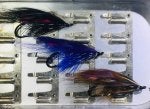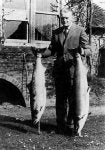Hi, flytie09. You are right, we're way behind you guys when it comes to using barbless hooks. They are compulsory on some stocked catch and release waters but very few salmon anglers use them as far as I'm aware.
My current river has now banned trebles but many others still permit their use. I've had the odd guest try to slip a treble on without my knowing but always put my foot down.
I stopped using them myself some years ago as in Lewis we can get a lot of finnock - maiden sea trout about 8 oz to 3/4 lb. They have soft, delicate mouths when fresh from the sea and a treble 'aimed at' a salmon will do severe damage to the wee fishes. In fact, the last time I saw a treble used here was a couple of years ago. A chap hooked and lost a 1 lb 1/4 sea trout and was bemoaning his misfortune.
I suggested he try four hooks next time.
 ......
...... :flame:
There used to be a fair bit of debate about the hooking qualities of trebles, doubles and single hooks here. Yes a treble has three points and has more chance of gaining a second hold in the mouth if the first hold gives but ..... can the third, upper point be used a leverage by the fish to weaken the hold and escape? To me now it's a moot point.

Thanks for the offer of the hooks but I'm well stocked, cheers. Anyway, you need them for posts like this one.

While we lag behind in hook etiquette we've come a long way regarding fish care whilst removing the hook and catch and release. Sadly a decade or more of C&R doesn't appear to have influenced catch rates but I'm sure it should still be practiced where stocks are poor.
Twenty-odd years ago I caught fish for a small system's hatchery brood stock. The fish were all fly-caught, revived in a net and transferred to large crates periodically located along the banks. Out of perhaps 100 fish we only ever lost two - and whether being caught contributed to their death we don't know. I thought that was a pretty good survival rate. In the cage, they were safe from the otters anyway!
They are pretty robust fish really, and when you consider the terrain they must run and falls they must climb it's not that surprising. I've yet to see a salmon launch itself onto the bank in a blind, reckless leap, then flap itself back in over rocks and gravel but it does happen. I have found them in the boat of a morning where they've stranded themselves overnight.
Breakfast, then. Gillie's perks.

Similarly, we probably lack behind you guys and the Scandi nations in tactical development. Although Spring salmon tend to lie and run deep in the colder water they will rise up for a fly more readily when about 62' F is reached - April/May - and then floating lines come to the fore, i.e. there's seldom a need to get deep (on the waters I've known, anyway). Perhaps that's why so little 'up & across' is seen.
We tend to use heavy, long tubes on sinking lines for Spring fish - you have to get down to them, almost hit them on the nose.
However, once the water has warmed the fish will come up, even to the surface for a fly - but, it is said, never down! And they begin to prefer smaller flies like size 6s, 8s and even 10s.
Richard Waddington suggested that this was because when at sea and feeding in cold water their prey is large herring-like fish. But when their migration takes them through warmer water they feed on shrimp and prawn and other smaller creatures. On returning to fresh water the latent memory of temperature/prey size affects their behavior and, accordingly, the size of fly they will take. It's an interesting theory from an interesting, innovative writer. I recommend his books to anyone visiting the Spey and similar Highland rivers.
I don't have that Chris Mann book but I do have his 'Complete Illustrated Directory of Salmon Flies' next door. The text is bound to be similar and I'll look up the G.P. tomorrow and report back.

I have to say, the Colonel does look like a decent chap. Old school, but a kindly face.
Yours aye,
James.
Edit: I think those fine salmon are tailed and on sticks which Col. D is holding - not their tails!



